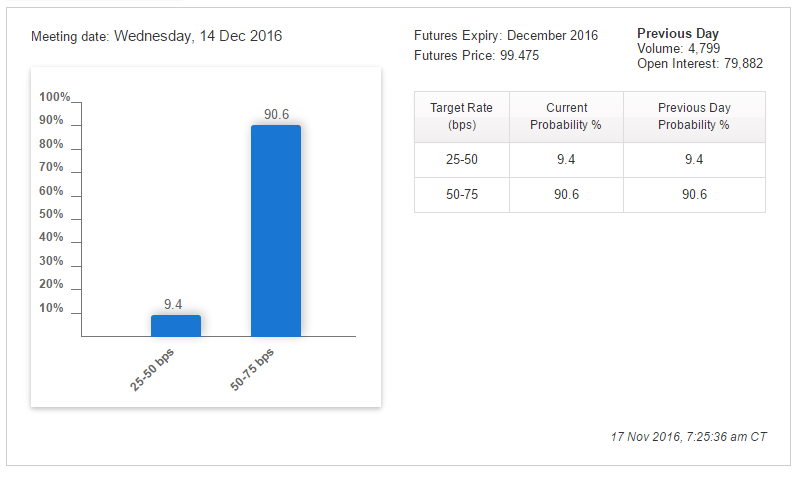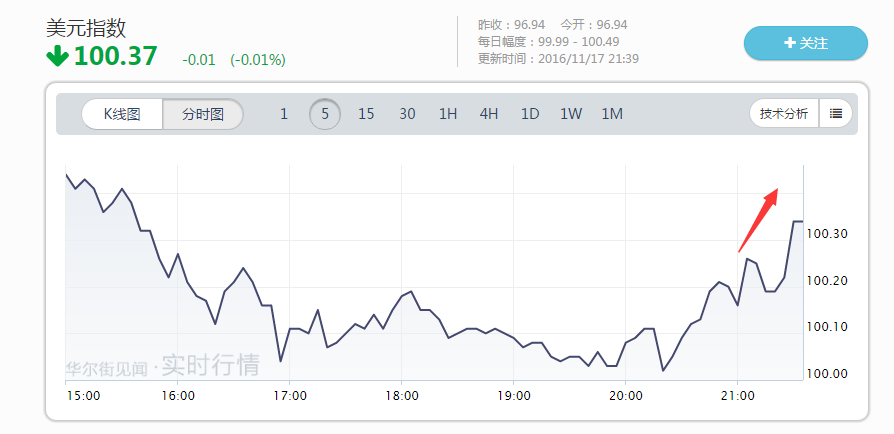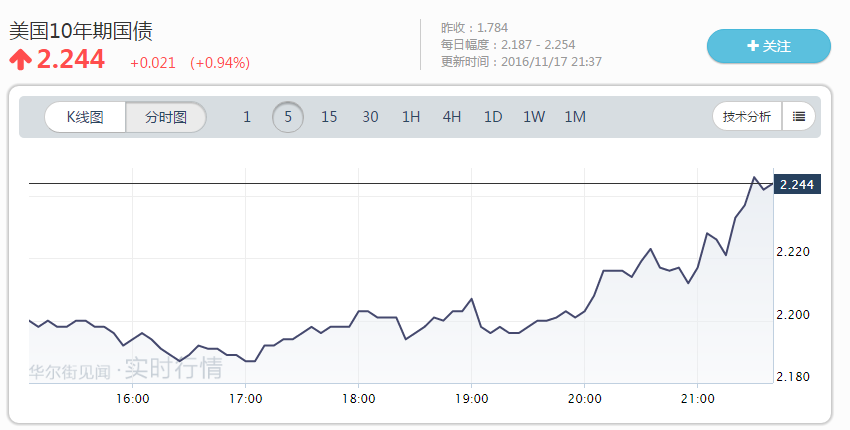美联储主席耶伦表明快加息 等待太久有危险

美联储主席耶伦在国会联合经济委员会听证的演讲稿出炉,CNBC称耶伦就加息给出了目前最为鹰派的言论。
耶伦认为,如果未来的数据进一步表明更加靠近美联储的目标,这样的一次加息可能很快会变成合适的(耶伦原文为:At our meeting earlier this month, the Committee judged that the case for an increase in the target range had continued to strengthen and thatsuch an increase could well become appropriate relatively soon if incoming data provide some further evidence of continued progress toward the Committee's objectives.),等待太久可能会导致美联储日后不得不过快作出改变。维持利率不变过久可能刺激过度的风险偏好。
(注:此前表述“相对快的加息是合适”易引发歧义,现已修正为“这样的一次加息很快会变成合适的”)
耶伦称,如果美联储延迟过久加息,最后的结果可能会是日后不得不突然收紧政策,以使经济符合美联储的长期目标。
耶伦表示,美国经济朝向美联储目标更进一步。随着劳动力市场改善,通胀率将向2%攀升。美国经济增速已经从先前受抑制的状态中有所抬头。不过,消费者支出温和,商业投资疲软。
不过,如往常一样,耶伦再度强调了将逐步采取行动。未来落后于收益率曲线的风险不大,逐步加息对于未来数年保持中性货币立场应该是有效的。
针对就业问题,耶伦称,近期薪资增速有上升迹象,劳动力市场可能还有一些增长的空间。稳定的失业率令经济有更多空间运作。少数群体失业率偏高令人困扰。
市场一度猜测特朗普当选会否延迟美联储加息进程,耶伦的演讲稿并没有讲述这个问题。不过,就联邦基金期货利率来看,目前市场高度认为美联储12月将加息。
联邦基金期货利率显示,市场目前认为美联储12月加息的概率高达90.6%。

耶伦将在北京时间23:00正式作证词并回答提问。
美联储主席耶伦证词公布后,美股期货维持基本不变,美债价格小幅下跌,美元指数上扬。


以下是英文演讲稿:
ChairJanet L. Yellen
The Economic Outlook
Before the Joint Economic Committee, U.S. Congress, Washington, D.C.
November17,2016
Chairman Coats, Ranking Member Maloney, and members of the Committee, I appreciate the opportunity to testify before you today. I will discuss the current economic outlook and monetary policy.
The Economic Outlook
The U.S. economy has made further progress this year toward the Federal Reserve's dual-mandate objectives of maximum employment and price stability. Job gains averaged180,000 per month from January through October, a somewhat slower pace than last year but still well above estimates of the pace necessary to absorb new entrants to the labor force. The unemployment rate, which stood at4.9 percent in October, has held relatively steady since the beginning of the year. The stability of the unemployment rate, combined with above-trend job growth, suggests that the U.S. economy has had a bit more"room to run" than anticipated earlier. This favorable outcome has been reflected in the labor force participation rate, which has been about unchanged this year, on net, despite an underlying downward trend stemming from the aging of the U.S. population. While above-trend growth of the labor force and employment cannot continue indefinitely, there nonetheless appears to be scope for some further improvement in the labor market. The unemployment rate is still a little above the median of Federal Open Market Committee(FOMC) participants' estimates of its longer-run level, and involuntary part-time employment remains elevated relative to historical norms. Further employment gains may well help support labor force participation as well as wage gains; indeed, there are some signs that the pace of wage growth has stepped up recently. While the improvements in the labor market over the past year have been widespread across racial and ethnic groups, it is troubling that unemployment rates for African Americans and Hispanics remain higher than for the nation overall, and that the annual income of the median African American household and the median Hispanic household is still well below the median income of other U.S. households.
Meanwhile, U.S. economic growth appears to have picked up from its subdued pace earlier this year. After rising at an annual rate of just1 percent in the first half of this year, inflation-adjusted gross domestic product is estimated to have increased nearly3 percent in the third quarter. In part, the pickup reflected some rebuilding of inventories and a surge in soybean exports. In addition, consumer spending has continued to post moderate gains, supported by solid growth in real disposable income, upbeat consumer confidence, low borrowing rates, and the ongoing effects of earlier increases in household wealth. By contrast, business investment has remained relatively soft, in part because of the drag on outlays for drilling and mining structures that has resulted from earlier declines in oil prices. Manufacturing output continues to be restrained by the weakness in economic growth abroad and by the appreciation in the U.S. dollar over the past two years. And while new housing construction has been subdued in recent quarters despite rising prices, the underlying fundamentals–including a lean stock of homes for sale, an improving labor market, and the low level of mortgage rates–are favorable for a pickup.
Turning to inflation, overall consumer prices, as measured by the price index for personal consumption expenditures, increased1-1/4 percent over the12 months ending in September, a somewhat higher pace than earlier this year but still below the FOMC's2 percent objective. Much of this shortfall continues to reflect earlier declines in energy prices and in prices of non-energy imports. Core inflation, which excludes the more volatile energy and food prices and tends to be a better indicator of future overall inflation, has been running closer to1-3/4 percent.
With regard to the outlook, I expect economic growth to continue at a moderate pace sufficient to generate some further strengthening in labor market conditions and a return of inflation to the Committee's2 percent objective over the next couple of years. This judgment reflects my view that monetary policy remains moderately accommodative and that ongoing job gains, along with low oil prices, should continue to support household purchasing power and therefore consumer spending. In addition, global economic growth should firm, supported by accommodative monetary policies abroad. As the labor market strengthens further and the transitory influences holding down inflation fade, I expect inflation to rise to2 percent.
Monetary Policy
I will turn now to the implications of recent economic developments and the economic outlook for monetary policy. The stance of monetary policy has supported improvement in the labor market this year, along with a return of inflation toward the FOMC's2 percent objective. In September, the Committee decided to maintain the target range for the federal funds rate at1/4 to1/2 percent and stated that, while the case for an increase in the target range had strengthened, it would, for the time being, wait for further evidence of continued progress toward its objectives.
At our meeting earlier this month, the Committee judged that the case for an increase in the target range had continued to strengthen and that such an increase could well become appropriate relatively soon if incoming data provide some further evidence of continued progress toward the Committee's objectives. This judgment recognized that progress in the labor market has continued and that economic activity has picked up from the modest pace seen in the first half of this year. And inflation, while still below the Committee's2 percent objective, has increased somewhat since earlier this year. Furthermore, the Committee judged that near-term risks to the outlook were roughly balanced.
Waiting for further evidence does not reflect a lack of confidence in the economy. Rather, with the unemployment rate remaining steady this year despite above-trend job gains, and with inflation continuing to run below its target, the Committee judged that there was somewhat more room for the labor market to improve on a sustainable basis than the Committee had anticipated at the beginning of the year. Nonetheless, the Committee must remain forward looking in setting monetary policy. Were the FOMC to delay increases in the federal funds rate for too long, it could end up having to tighten policy relatively abruptly to keep the economy from significantly overshooting both of the Committee's longer-run policy goals. Moreover, holding the federal funds rate at its current level for too long could also encourage excessive risk-taking and ultimately undermine financial stability.
The FOMC continues to expect that the evolution of the economy will warrant only gradual increases in the federal funds rate over time to achieve and maintain maximum employment and price stability. This assessment is based on the view that the neutral federal funds rate–meaning the rate that is neither expansionary nor contractionary and keeps the economy operating on an even keel–appears to be currently quite low by historical standards. Consistent with this view, growth in aggregate spending has been moderate in recent years despite support from the low level of the federal funds rate and the Federal Reserve's large holdings of longer-term securities. With the federal funds rate currently owhich has been about unchanged tthe neutral rate, the stance of monetary policy is likely moderately accommodative, which is appropriate to foster further progress toward the FOMC's objectives. But because monetary policy is only moderately accommodative, the risk of falling behind the curve in the near future appears limited, and gradual increases in the federal funds rate will likely be sufficient to get to a neutral policy stance over the next few years.
Of course, the economic outlook is inherently uncertain, and, as always, the appropriate path for the federal funds rate will change in response to changes to the outlook and associated risks.
Thank you. I would be pleased to answer your questions.
来源:华尔街见闻 转载请注明作者、出处並保持完整。


